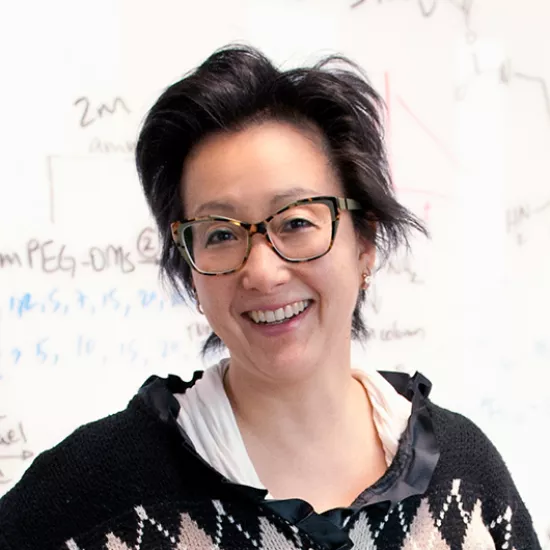
Jumi A. Shin
-
E-mail:
-
Mailing Address:
3359 Mississauga Road
Mississauga ON L5L 1C6
Canada
Education:
B.A., Chemistry, Cum Laude. Harvard University, Cambridge, Massachusetts.
Ph.D., Chemistry. California Institute of Technology, Pasadena, California.
Research Areas:
Biological Chemistry: protein design & engineering, directed evolution, anti-cancer protein drugs, genomic mutations from nanoparticle & quantum-dot exposure.

Research Profile:
The multidisciplinary Shin lab focuses on exploiting the building blocks that nature uses, including proteins and nucleic acids, toward solving problems in human health and our environment and ecosystem. We design small proteins that bind to specific DNA targets toward regulation of gene expression, particularly those involved in cancer and disease. Protein structure and function is analyzed by various spectrosopic methods including fluorescence (FRET, anisotropy), circular dichroism and x-ray crystallography, as well as biological assays (yeast and bacterial one-hybrid) and testing in cancer cell lines and mouse models.
To make our frankenproteins, we take modules from different natural proteins and stitch them together to make new protein tools. For example, some of our proteins target the Myc/Max/E-box gene network that is involved in >70% of human cancers. These frankenproteins could serve in the next-generation anti-cancer drug arsenal that includes protein drugs. Some of our proteins can up and downregulate gene circuits in cells. This is useful in synthetic biology applications that can produce high-value compounds in bacterial or yeast cells, for example.
Courses Taught:
CHM242 & CHM462 (undergraduate), CHM1054 & CHM1056 (graduate)
Publications
For an overview of her transdisciplinary work designing and developing peptide therapeutics - https://www.biomedicine.video/medical-devices-pharmaceuticals/designing-developing-therapeutic-proteins-jumi-shin
Recent:
"J. A Shin. Targeting MYC with protein drugs. Progress in Molecular Biology and Translation Science, 2024, https://doi.org/10.1016/bs.pmbts.2024.07.001"
"R. Edaibis, R. Akel, J.A. Shin. Beyond small molecules: advancing MYC-targeted cancer therapies through protein engineering. Transcription, 2024, https://www.tandfonline.com/doi/full/10.1080/21541264.2025.2453315"
"Combining a Base Deaminase Mutator with Phage-Assisted Evolution." M. Ali, R. Akel, M. Botero, & J. A. Shin. Phage Engineering and Analysis. Methods in Molecular Biology (Springer Nature, Humana Press, New York), 2024. https://doi.org/10.1007/978-1-0716-3798-2_4.
"Combining Rational Design and Continuous Evolution on Minimalist Proteins That Target the E-box DNA Site." I. Inamoto, I. Sheoran, S. C. Popa, M. Hussain, & J. A. Shin. ACS Chem. Biol., 2020, DOI: doi/10.1021/acschembio.0c00684.
"Phage Assisted Continuous Evolution (PACE): a How-to Guide for Directed Evolution." S. C. Popa, I. Inamoto, B. W. Thuronyi, & J. A. Shin. ACS Omega, 2020, DOI: 10.1021/acsomega.0c03508.
"The intrinsically disordered loop in the USF1 bHLHZ domain modulates its DNA-binding sequence specificity in hereditary asthma." S. C. Popa & J. A. Shin. Journal of Physical Chemistry B, 2019. DOI: 10.1021/acs.jpcb.9b06719.
"Peptide therapeutics that directly target transcription factors." Ichiro Inamoto & J. A. Shin. Peptide Science, 2019, 111, 1-11. DOI: 10.1002/pep2.24048.
"Inhibiting MYC binding to the E-box DNA motif by ME47 decreases tumour xenograft growth." L. C. Lustig, D. Dingar, W. Tu, C. Lourenco, M. Kalkat, I. Inamoto, R. Ponzielli, W. C. W. Chan, J. A. Shin, & L. Z. Penn. Oncogene, 2017, 36, 6830-6837. DOI: 10.1038/onc.2017.275.
"Yeast Populations Evolve to Resist CdSe Quantum Dot Toxicity." A. Strtak, S. Sathiamoorthy, P. S. Tang, K. M. Tsoi, F. Song, J. B. Anderson, W. C. W. Chan., and J. A. Shin. Bioconjugate Chemistry, 2017. DOI: 10.1021/acs.bioconjchem.7b00056.
Below article in red has been selected as HOT article! (a HOT article contains research which has been highlighted by the reviewers as being particularly interesting or particularly significant research). Download a copy from HERE
"The DNA target determines the dimerization partner selected by bHLHZ-like hybrid proteins AhrJun and ArntFos." I. Inamoto, G. Chen, & J. A. Shin. Molecular Biosystems, 2017, DOI: 10.1039/C6MB00795C.
"The Role of Ligand Density and Size in Mediating Quantum Dot Nuclear Transport." P. Tang, S. Sathiamoorthy, L. Lustig, R. Ponzielli, I. Inamoto, L. Z. Penn, J. A. Shin, & W. C. W. Chan. Small, 2014, 10, 4182–4192. DOI: 10.1002/smll.201401056.
"Boundaries of the Origin of Replication: Creation of a pET-28a-Derived Vector with p15A Copy Control Allowing Compatible Coexistence with pET Vectors." S. Sathiamoorthy & J. A. Shin. PLoS ONE, 2012, 7, e47259. doi:10.1371/journal.pone.0047259.
"The bZIP Dimer Localizes at DNA Full-Sites Where Each Basic Region Can Alternately Translocate and Bind to Subsites at the Half-Site." I. Chan, T. Al-Sarraj, H. S. Shahravan, A. V. Fedorova, & J. A. Shin. Biochemistry, 2012, 51, 6632-6643.
"FRep: a fluorescent protein-based bioprobe for in vivo detection of protein:DNA interactions." S. H. Shahravan, I. T. Li, K. Truong, & J. A. Shin. Analytical Chemistry, 2011, 83, 9643-9650.
"Max-E47, a designed minimalist protein that targets the E-box DNA site in vivo and in vitro." J. Xu, G. Chen, A. T. De Jong, S. H. Shahravan, & J. A. Shin. Journal of the American Chemical Society, 2009, 131, 7839-7848.
"Design of a single plasmid-based modified yeast one-hybrid system for investigation of in vivo protein-protein and protein-DNA interactions." G. Chen, L. M. DenBoer, & J. A. Shin. BioTechniques, 2008, 45, 295-304.
